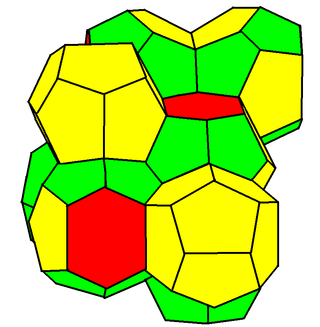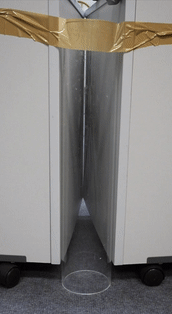Related Research Articles

John Lighton Synge was an Irish mathematician and physicist, whose seven-decade career included significant periods in Ireland, Canada, and the USA. He was a prolific author and influential mentor, and is credited with the introduction of a new geometrical approach to the theory of relativity.

In geometry, the Weaire–Phelan structure is a three-dimensional structure representing an idealised foam of equal-sized bubbles, with two different shapes. In 1993, Denis Weaire and Robert Phelan found that this structure was a better solution of the Kelvin problem of tiling space by equal volume cells of minimum surface area than the previous best-known solution, the Kelvin structure.
John Michael David Coey, known as Michael Coey, is a Belfast-born experimental physicist working in the fields of magnetism and spintronics. He is an Emeritus professor at the Trinity College Dublin (TCD).

Thomas Elrington was an Irish academic and bishop. He was Donegall Lecturer in Mathematics (1790-1795) at Trinity College Dublin (TCD). While at TCD he also served as Erasmus Smith's Professor of Mathematics (1795–1799) and as Erasmus Smith's Professor of Natural and Experimental Philosophy (1799–1807). Later, he was Provost of Trinity College Dublin (1811-1820), then Bishop of Limerick, Ardfert and Aghadoe (1820-1822), and finally Bishop of Ferns and Leighlin till his death in Liverpool in 1835.

Hugh Hamilton was a mathematician, natural philosopher (scientist) and professor at Trinity College Dublin, and later a Church of Ireland bishop, Bishop of Clonfert and Kilmacduagh and then Bishop of Ossory.

Petros Serghiou Florides was a Greek Cypriot mathematical physicist.

Jonathan Coleman is the Erasmus Smith's Professor of Natural and Experimental Philosophy in the School of Physics and a Principal Investigator in CRANN at Trinity College Dublin. Coleman's research focuses on solution-processing of nanomaterials and their use in applications. He is most well known for the development of liquid phase exfoliation, a widely used method for preparing two-dimensional nanosheets.

Bartholomew Lloyd (1772–1837) was an Irish mathematician and academic whose entire career was spent at Trinity College Dublin. As Erasmus Smith's Professor of Mathematics there, he promoted significant curricular reforms, including the introduction of the teaching of calculus. Later he served as Provost of the college.

Erasmus Smith's Professor of Natural and Experimental Philosophy at Trinity College Dublin is a chair in physics founded in 1724 and funded by the Erasmus Smith Trust, which was established by Erasmus Smith, a wealthy London merchant, who lived from 1611 to 1691. It is one of the oldest dedicated chairs of physics in Britain and Ireland. Originally, the holder was to be elected from the members of the college by an examination to determine the person best qualified for the professorship. Since 1851, the professorship has been supported by Trinity College. Of the 22 holders of this chair, seven were Fellows of the Royal Society while one, Ernest Walton, won the Nobel Prize for Physics.
Edward Hutchinson Synge was an Irish physicist who published a complete theoretical description of the near-field scanning optical microscope, an instrument used in nanotechnology, several decades before it was experimentally developed. He never completed university yet did significant original research in both microscopy and telescopy. He was the first to apply the principle of scanning in imaging, which later became important in a wide range of technologies including television, radar, and scanning electron microscopy. He was the older brother of distinguished mathematician and theoretical physicist John Lighton Synge.
The University Chair of Natural Philosophy is a professorship in the School of Mathematics at Trinity College Dublin. It was established in 1847.
Matthew Wyatt Joseph Fry was an Irish mathematician and academic who served as Professor of Natural Philosophy at Trinity College Dublin (TCD) from 1910 to 1925.
The Erasmus Smith's Professor of Mathematics at Trinity College Dublin is one of two endowed mathematics positions at Trinity College Dublin (TCD), the other being the Donegall Lectureship at Trinity College Dublin. It was founded in 1762 and funded by the Erasmus Smith Trust, which was established by Erasmus Smith (1611–1691). Since 1851 the position has been funded by Trinity College.
James Wilson was an Irish mathematician whose career was spent at Trinity College Dublin (TCD). He was born in Dublin, his father being William, and was brought up there. He studied at TCD, graduating BA (1794), MA (1800) and later BD & DD (1811).
Brian Hughes Murdoch was an Irish mathematician who served for 23 years as Erasmus Smith's Professor of Mathematics at Trinity College Dublin (TCD). He was an analyst with expertise in potential functions and random walks.
Paul Matthew Niall Feehan studied electrical engineering at University College Dublin and the University of Missouri at Rolla, before switching to mathematics. His 1992 Ph.D. on "Geometry of the Moduli Space of Self-Dual Connections on the Four-Sphere" was done at Columbia University under Duong Hong Phong.
William Davenport (1772–1823) was an Irish academic. He was the eighth Erasmus Smith's Professor of Natural and Experimental Philosophy at Trinity College Dublin (TCD), serving in that role from 1807 to 1822.
Thomas Wilson was an Irish academic and clergyman most of whose career was spent at Trinity College Dublin (TCD), where he served as the fifth Erasmus Smith's Professor of Natural and Experimental Philosophy (1769–1786).

Sphere packing in a cylinder is a three-dimensional packing problem with the objective of packing a given number of identical spheres inside a cylinder of specified diameter and length. For cylinders with diameters on the same order of magnitude as the spheres, such packings result in what are called columnar structures.

Luke O’Connor Drury is an Irish mathematician and astrophysicist at the Dublin Institute for Advanced Studies (DIAS) with research interests in plasma physics, particle acceleration, gas dynamics, shock waves, and cosmic rays. He was President of the Royal Irish Academy from 2011 to 2014.
References
- ↑ The International Who's Who 2004. Europa Publications. p. 1782.
- 1 2 Erasmus Smith's professors of Mathematics Mathematics at TCD 1592–1992
- ↑ Fountain, Henry (5 August 2008). "A problem of bubbles frames an Olympic design". New York Times. Retrieved 9 October 2008.
- ↑ Winkelmann, J.; Haffner, B.; Weaire, D.; Mughal, A.; Hutzler, S. (31 July 2017). "Corrected Article: Simulation and observation of line-slip structures in columnar structures of soft spheres [Phys. Rev. E 96, 012610 (2017)]". Physical Review E. 97 (5): 059902. doi: 10.1103/PhysRevE.97.059902 .
- ↑ "ShieldSquare Captcha". doi:10.1209/0295-5075/127/44002/meta.
{{cite journal}}: Cite journal requires|journal=(help) - ↑ Winkelmann, J.; Mughal, A.; Williams, D. B.; Weaire, D.; Hutzler, S. (25 February 2019). "Theory of rotational columnar structures of soft spheres". Physical Review E. 99 (2): 020602. arXiv: 1808.02952 . doi:10.1103/PhysRevE.99.020602.
- ↑ Mughal, A.; Winkelmann, J.; Weaire, D.; Hutzler, S. (18 July 2023). "Stability maps for columnar structures". Philosophical Magazine. 103 (14): 1328–1344. doi: 10.1080/14786435.2023.2208885 . ISSN 1478-6435.
- ↑ "Board Members". EPS History of Physics Group. 27 December 2021. Retrieved 26 September 2022.
- ↑ Donegan, J.F.; Weaire, D.; Florides, P., eds. (19 April 2012). Hutchie: The Life and Works of Edward Hutchinson Synge (1890–1957). Living Edition. ISBN 978-3-901585-17-3.
- 1 2 TIME Archive: The Ira Einhorn Case. 20 July 2001. Retrieved 17 September 2016.